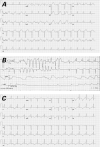Acquired Long QT Syndrome after Acute Myocardial Infarction: A Rare but Potentially Fatal Entity
- PMID: 32603470
- PMCID: PMC7328093
- DOI: 10.14503/THIJ-18-6872
Acquired Long QT Syndrome after Acute Myocardial Infarction: A Rare but Potentially Fatal Entity
Abstract
Acquired long QT syndrome is typically caused by medications, electrolyte disturbances, bradycardia, or catastrophic central nervous system events. We report a case of myocardial infarction-related acquired long QT syndrome in a 58-year-old woman that had no clear cause and progressed to torsades de pointes requiring treatment with isoproterenol and magnesium. Despite negative results of DNA testing against a known panel of genetic mutations and polymorphisms associated with long QT syndrome, the patient's family history of fatal cardiac disease suggests a predisposing genetic component. This report serves to remind clinicians of this potentially fatal ventricular arrhythmia after myocardial infarction.
Keywords: Long QT syndrome/etiology/genetics; myocardial infarction; torsades de pointes.
© 2020 by the Texas Heart® Institute, Houston.
Figures


References
-
- El-Sherif N, Turitto G, Boutjdir M. Acquired long QT syndrome and torsade de pointes. Pacing Clin Electrophysiol. 2018;41(4):414–21. - PubMed
-
- Ahnve S. QT interval prolongation in acute myocardial infarction. Eur Heart J. 1985;6 Suppl D:85–95. - PubMed
-
- Halkin A, Roth A, Lurie I, Fish R, Belhassen B, Viskin S. Pause-dependent torsade de pointes following acute myocardial infarction: a variant of the acquired long QT syndrome. J Am Coll Cardiol. 2001;38(4):1168–74. - PubMed
-
- Antzelevitch C, Sicouri S. Clinical relevance of cardiac arrhythmias generated by afterdepolarizations. Role of M cells in the generation of U waves, triggered activity and torsade de pointes. J Am Coll Cardiol. 1994;23(1):259–77. - PubMed
Publication types
MeSH terms
Grants and funding
LinkOut - more resources
Full Text Sources
Medical

